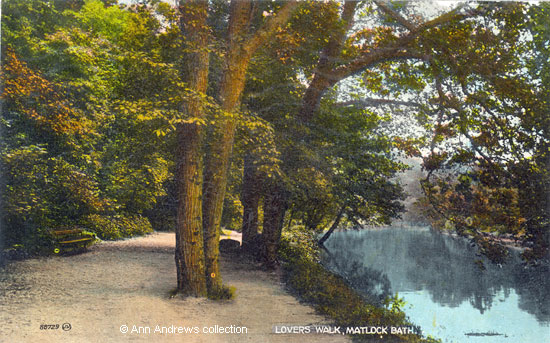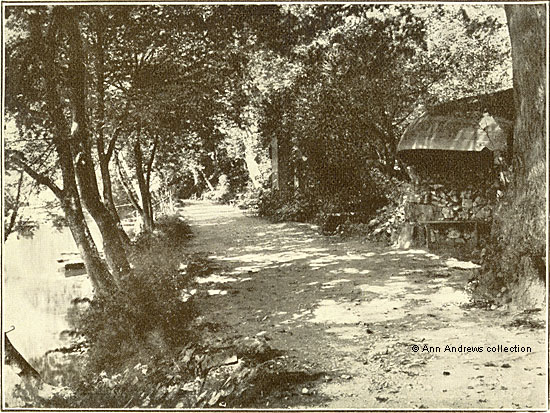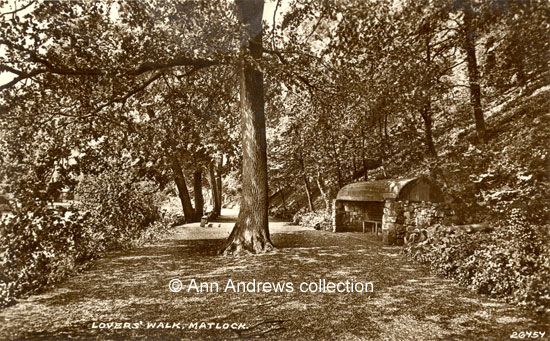|
Images Index> Matlock Bath, 20th and 21st Century Images> This page |
| Matlock Bath: Lovers' Walks |
| Matlock Bath : Twentieth Century Photographs, Postcards, Engravings & Etchings |
|
|||||||
In 1869 Thomas Walker sued Herbert Buxton for trespass on a part of the Lovers' Walks in a case about boating rights. Whilst giving evidence Mr. Walker stated that he "rented the Lover's Walks, for which he paid Mr. Arkwright £5 per year, which, considering that the walks had been made by his family, who had been tenants for 100 years, was sufficient rent"[3a]. Until the Jubilee Bridge was opened in 1887 access was only available by either the river ferry or from the grounds of Willersley Castle to the south. In 1897, following Mrs. Ratcliffe's death, Matlock Bath Council leased the Lovers' Walks for a period of 21 years at a rent of £40 per. annum[5]. Frederic Charles Arkwright died in 1923 and the Willersley estate, including the Lovers' Walks, was put up for sale[6]. When it eventually sold in 1927 the Council (by then the Matlocks Urban Council) was holding another lease for Lovers' Walks that still has twenty years to run. There were boating and fishing rights included in the lease. Sir Albert Ball had bought Willersley but resold the lot of the Lovers' Walks almost immediately to G. H. Drabble, a well-known local timber merchant[7]. The Council had tried to buy the walks at the sale, as they wished them to be preserved as a pleasure resort in perpetuity, but were obviously outbid. However, they continued to negotiate but by December that year it became apparent that reaching an agreement with the new owner was impossible. Many feared that Harry Drabble might decide to exercise his right to cut down the timber though enjoyment by the general public was assured for another 20 years, anyway, because of the existing lease[8].
Shortly after this, the Council announced that people who lived in Matlock, Cromford, and Tansley would not have to pay an entry fee to use the grounds. Matlock Bath residents had not paid to use the walks for some time and including others in the locality was done in the interest of fairness[11]. The Council agreed a scheme to light Lovers' Walks in 1934[12].
In the Spring of 1935 a compulsory purchase order, partly reproduced below, was published in the local press.
Extract from the Compulsory Purchase Order
relating to Lovers' Walks[14].
As for Sunday boating, the following year the Council's Finance Committee agreed that it should be allowed. On the very first Sunday "boating was duly enjoyed until the rain came"[17]. Lovers' Walks is protected today as it is now Grade II* listed and is one of three registered Historic Parks and Gardens within the Matlock Bath Conservation Area[18].
|
|||||||
1. "Lovers Walk, Matlock Bath". Valentine's Series No.98656? Valentine's Series is a guarantee of British Manufacture. First published in 1926?, although a black and white version was posted in 1924. Not posted. 2. "Lovers Walk, Matlock Bath". Valentine's Colourtone Series, No.88729, Copyright Picture. Printed in Great Britain. First published 1923. Posted 21 May 1929 at Matlock. 3. "Lovers Walk, Matlock Bath". Photographic postcard published by Judges Ltd., Hastings, No. 19845. Unused, but published in 1938. 4. "Lovers Walk, Matlock". Photo by Winter, Derby. Date unknown. Published in"The Matlocks, Derbyshire. Official Guide". Issued by the Come to Derbyshire Association, published 1930s but would have been taken a considerable time before that. 5. "Lovers' Walk, Matlock". No publisher, No.26757. This is a real photograph. Posted on 4 Sep 1937 at Matlock. Postcards and other images in the collection of, provided by and © Ann Andrews. Written, researched by and © Ann Andrews. Intended for personal use only. |
|||||||
References (coloured links are to transcripts or more information elsewhere on this web site): [1] More information about the Walkers can be found on Matlock Bath: Bath Terrace Hotel | The Royal Museum (Smith's), South Parade | Walker's Marble Museum (Bemrose Guide advert). [2] There is more about Mrs. Ratcliffe on Matlock Bath : The Ferry [3] "Derbyshire Courier", 6 July 1872. George Ratcliffe placed several notices in the press stating that the Lovers' Walks had been closed for a short time but would shortly re-open. [3a] "Derbyshire Times", 22 May 1869. Wirksworth County Court. Important River Trespass at Matlock Bath. An Old grievance. Thomas Walker was the proprietor of the Royal Museum by this time. [5] Bryan, Benjamin (1903) "History of Matlock - Matlock, Manor and Parish" London by Bemrose & Sons, Limited. [6] The estate failed to attract a buyer, and both the house contents and the estate were eventually sold at auction. See, for example: Willersley Castle Contents Sale, 1927 and Willersley Castle Estate Sale, 1927. [7] "Derby Daily Telegraph", 6 June 1927. G. H. Drabble, known as Harry Drabble, was the son of George Stendall Drabble of The Limes, Matlock. [8] "ibid", 21 December 1927. Lovers' Walks. It was acknowledged that he was known to be a man of public spirit and it was deemed both premature and unfair that he intended to destroy one of the chief attractions of Matlock Bath. [9] "ibid", 15 January 1929. Lovers' Walks to be left alone. [10] "ibid", 3 July 1929. Sunday boating. [11] "ibid", 31 July 1929. Matlock, Cromford and Tansley residents now paid the same rates as the people of Matlock Bath as the councils had amalgamated. [12] "ibid", 17 July 1934. Scheme for electrical Illumination. [13] "Derbyshire Times", 25 March 1933. [14] "ibid.", 26 April 1935. [15] "ibid", 21 August 1936. Lovers' Walks. Purchase Price Criticised at Matlock Council. [16] "Derby Daily Telegraph", 19 January 1937. The final cost of the walks, together with piece of land at Smedley street, was £3,500. [17] "ibid", 18 May 1937. [18] The Grade 2* listing is number 10011416, dated 3rd August 1984. |
















 Read Betjeman's poem that mentions
the Lovers' Walks on
Read Betjeman's poem that mentions
the Lovers' Walks on